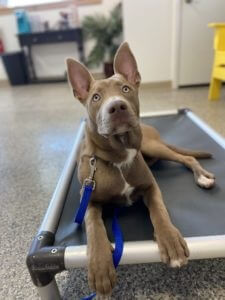5 Basic Commands Your Dog Should Know
You’re bringing home your first puppy, but you’ve also been binge-watching dog shows on television. You’ve seen dogs that can open refrigerator doors, dogs that can count, and dogs that can save human lives. You are getting overwhelmed and are wondering what kind of dog training to start with — what’s the most important?
The answer is that every dog needs a foundational set of skills. These skills allow you to interact with your dog on a basic level, and they establish important concepts for the dog to follow. They have a wide variety of situational uses, too, so learning just a few can get you a long way for your efforts.
Puppies learn fairly quickly, and so do old dogs. You have years to teach your dog to ring a doorbell or walk a highwire. What you need to do immediately, though, is to teach the newest member of your household how to be a polite companion. The last thing you want is the feeling of having to tell family and friends to avoid visiting your home because of your out-of-control canine.
While opinions will vary, here are five basic commands that we believe every dog should know (in no particular order):
- Off/Down
- Leave It
- Wait
- Drop It
- Come
Let’s take a closer look at each of these commands and why they are important.
The “Off”/”Down” Command
When you bring a dog home and give it a name, it might quickly confuse its new moniker with the word “no”. You will find yourself telling your pup “no” more than you say its name. Puppies are mischievous little creatures that need to be taught how to behave properly.
While saying “no” can be helpful, teaching an “off” or “down” command is more specific yet more versatile. Teaching your dog “off” can help you in a variety of situations. When your dog obeys “off” reliably, you can use the word to tell your dog to stop jumping on guests, to get off of the couch, and to quit surfing the counters.
Off is an important command because it can help your dog become a pleasant animal to spend your life with. It will teach him what is permissible and what is not. It’s not okay to jump on people, it may not be okay to crawl into your bed, and it is never okay to take things off the counter.
The “Leave It” Command
Regardless of what you call your dog’s front feet, canines do not have hands. Human babies explore with their hands and puppies explore with their mouths. You can imagine how much trouble this could get a curious pup into.
By teaching your dog the “leave it” command, you are giving them a clear idea of what they are allowed to put in their mouth and what they aren’t. It’s perfectly fine for your puppy to chew on a dog toy, but it isn’t okay for them to take socks, underwear, remote controls, eyeglasses or any of your other personal belongings.
When your dog knows “leave it,” you are keeping them safe. If your dog grabs a sock and swallows it, you could be looking at surgery to keep them alive. If your dog chews your eyeglasses, they could cut the insides of their mouth and throat. When your dog understands what “leave it” means, they don’t pick up these items if you can catch them and deliver the command before they act.
Just as importantly, “leave it” can help them control their food-driven impulses. This is important when they’re eating something they’re not supposed to. This can include mysterious food picked up off a walk, but it can also mean a treat or chew meant for another dog. Learning self-control and obedience is key to avoiding unpleasant situations, whether they involve sickness or power struggles with other animals.
The “Wait” (or “Stay”) Command
When people think of obedience commands, they typically think of sit, down, and come. These are all great things to teach your dog — and we will talk about one of them in a moment — but don’t overlook the all-encompassing importance of the “wait” command.
Dogs want to be with us whenever they can. If you have ever had a dog, you know this because you run out of fingers when you try to count on one hand how many times you turned around and tripped over them. What happens when you go outside? What if you leave the backyard through the gate?
Your dog should never feel welcome to barrel through an open door. They shouldn’t think it’s okay to dive for the food bowl as soon as you set it on the floor. They shouldn’t assume it’s their turn to jump in the car …before you’ve gotten groceries or toddlers out of the way. A pushy dog is an ill-mannered dog. A dog who races through doors without a second thought is putting himself in danger. A reliable “wait” can help you teach your dog manners and keep them safe at the same time.
“Wait” also teaches your dog self-control in situations where it may be needed. For instance, if there’s a scrap at the dog park, and your dog is thinking about getting involved, a stern “wait” can mean the difference between avoiding conflict. Dogs who know how to “wait” can let their owner’s commands supersede their impulses, gaining critical control in scenarios where danger or uncertainty might be involved.
The “Drop It” Command
Someone, or someones, will invariably tell you that you need to supervise your new puppy at all times. You should be keeping an eye on your pup every second of the day. Let’s be realistic — even with the best of intentions, there are times when your dog will be left to its own devices.
Put another way, there’s the inevitable moment when you will find your dog carrying around something they shouldn’t be. By teaching your dog how to “drop it,” you are helping to keep both them and your property safe. It’s not unusual for a dog owner to look over their shoulder to see their puppy racing down the hallway with a pair of underwear in their mouth. They might also score some tasty vittles from an unguarded countertop. Your dog could gulp any of these items down fast then you can blink if they don’t learn a reliable “drop it.”
The “Come” Command
The “come” command is one of the hardest to teach a dog. Dogs want to do what they want to do when they want to do it. It’s important for your dog to know the “come” command for their own safety and your sanity.
If your dog darts past you on the way into the house to chase a rabbit, knowing “come” will get them to return to you before they get themselves into trouble. When your dog knows that you mean it when you say “come,” you don’t have to chase your dog around the yard in the dead of winter trying to get them back in the house!
Remember that an important part of “come” is rewarding the dog when they do return — even if they’re technically in trouble for bolting in the first place. Avoid making the dog feel punished for obeying the “come” command, and be sure to practice it in situations where there are no stakes involved. The more comfortable they are with coming on command, the less likely they are to disobey simply because there’s stress or uncertainty involved in the situation.
Greenlin Pet Resorts Can Help You Train Your Best Friend
Whether you already know how to train dogs or are a novice, we have a class for you! Obedience classes at Greenlin Pet Resorts are not only good for guardians, but they are a great way for your pooch to learn healthy socialization.
Our classes are designed to help you turn your pup into a dog you are happy to grow old with. We will help you train your dog to be an enjoyable, polite member of your family. From basic obedience to more advanced classes, we have something for every skill level. Call us today or contact us online to register for one of our classes or have your questions answered.

